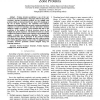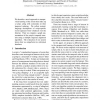441 search results - page 17 / 89 » Novel structures in Stanley sequences |
BMCBI
2008
13 years 9 months ago
2008
Background: We present a novel method of protein fold decoy discrimination using machine learning, more specifically using neural networks. Here, decoy discrimination is represent...
GECCO
2004
Springer
14 years 3 months ago
2004
Springer
Aligning multiple DNA or protein sequences is a fundamental step in the analyses of phylogeny, homology and molecular structure. Heuristic algorithms are applied because optimal mu...
CIBCB
2006
IEEE
14 years 3 months ago
2006
IEEE
– Protein structure prediction is one of the core research areas in bioinformatics. This paper addresses the protein secondary structure prediction problem for the twilight zone ...
ACL
2010
13 years 7 months ago
2010
We describe a novel approach to unsupervised learning of the events that make up a script, along with constraints on their temporal ordering. We collect naturallanguage descriptio...
ICIP
1999
IEEE
14 years 11 months ago
1999
IEEE
Information contained in the video sequences is crucial for an autonomous robot or a computer to learn and respond to its surrounding environment. In the past, robot vision is mai...


